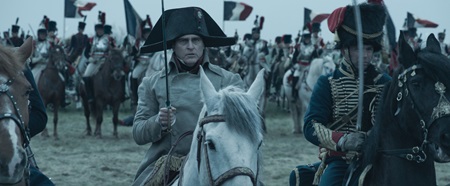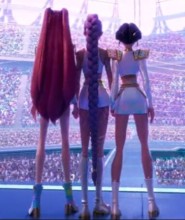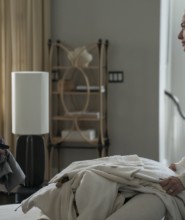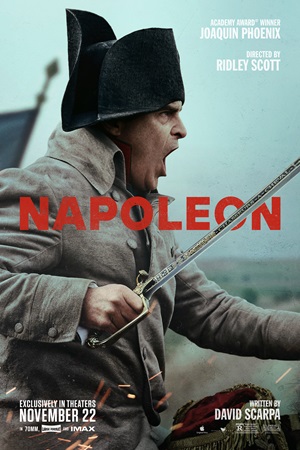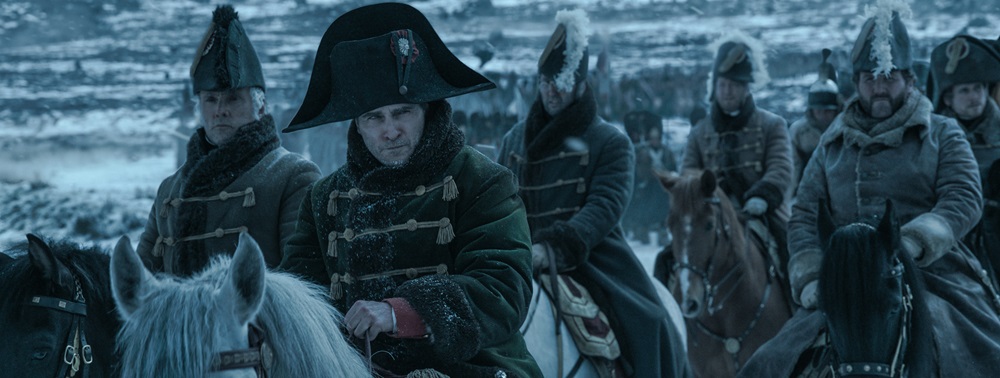
Scott’s Visually Resplendent Napoleon Meets its Cinematic Waterloo
From the standpoint of pure visual spectacle, Napoleon is right up there with anything director Ridley Scott has ever made. From the frigid battle at Austerlitz to the burning of Moscow to the French emperor’s final defeat at Waterloo on June 18, 1815, this is an astonishing epic of a petulant man’s rise and fall showcased on the grandest scale imaginable.
But Scott’s latest, a whirlwind of big ideas and lofty ambitions, is severely hampered by a frazzled structure and editing style that likely has everything to do with a much longer, nearly four-hour director’s cut that will be premiering on Apple TV+ in the next few months. While it’s somewhat strange to call a 156-minute motion picture “truncated,” that is exactly the case. Scenes do not fit together. Transitions are at best inelegant and at worst downright awkward. The relationship between Napoleon Bonaparte and Joséphine de Beauharnais never gels, and their whole journey from initial meeting through eventual divorce (for the good of France, naturally) is depicted in laborious fits and starts.
This disjointedness makes the film’s humor stand out for all the wrong reasons. It seems clear that Scott holds Bonaparte in contempt. This makes his flippant personality, wild mood swings, Three Stooges–like antics, and gluttonous appetites perfectly natural. But the problem is that, because the tone swings so violently from one scene to the next, there is no cohesion to how the character is depicted. It makes these bursts of comedy appear as if they are entirely out of left field, almost as if Scott is making this a Mel Brooks–style satire and not another one of his sprawling historical epics to sit alongside Gladiator or Kingdom of Heaven.
Because I do think the satirical largesse is by design, I’m much more open to the zany theatricality of star Joaquin Phoenix’s performance than I might have been. There is real magic to be found in his buffoonish grotesquerie, the slithery depravity of his emotional and petulant machinations juxtaposed nicely with his robust physicality and cutthroat battlefield demeanor. It’s an exuberantly self-indulgent star turn, and Phoenix holds nothing back, his cartoonishly virile venality consistently spellbinding.
I wish I felt the same about Vanessa Kirby as Joséphine. Her character is hurt the most by the film’s current iteration. She takes a more grounded approach to the material, and while this does help the audience relate to her more fully from an emotional standpoint, it also keeps Joséphine strangely distanced from Napoleon in ways that have little to nothing to do with the actual evolution of their romantic relationship. There are several instances where it is as if Kirby and Phoenix as in two completely different motion pictures, and that’s unfortunate.
It does all look incredible. Scott fills the screen with painterly massive images that are a sight to behold. Historians may scoff at how accurate these reenactments are in relation to those tumultuous early years of the 19th century, but dang does the director nevertheless stage each one with a level of extended magnificence that’s extraordinary.
The Austerlitz sequence is out of this world. Scott’s action choreography is crisp, clean, and bracingly visceral. Editors Claire Simpson (Platoon) and Sam Restivo keep things coherent yet still overflowing with adrenaline. The visual effects and the stunt work are exceptional, while cinematographer Dariusz Wolski (News of the World) crafts riveting images that are like something out of a beauteously gut-wrenching battlefield nightmare.
The question is, does any of that matter if I didn’t care about the people involved or have even a minimal personal investment in the outcome? While I could appreciate the technical virtuosity on display, the whole is never as interesting or entertaining as many of the pieces are. By his own admission, this incarnation of Napoleon is only a cracked shell of what Scott originally wanted to deliver, so that it does not fully work is hardly a surprise.
Film Rating: 2½ (out of 4)


